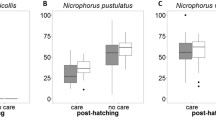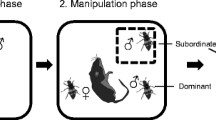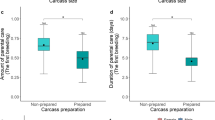Abstract
In species that provide parental care, offspring survival is often completely dependent on protection and resources afforded by the parents. Therefore, parents gain no fitness unless they raise offspring to a critical point of independence. In these species, selection should shape parental life history to increase their chances of surviving to this critical point. We test this hypothesis using females of two species of burying beetles, Nicrophorus orbicollis and N. marginatus. Burying beetles breed on small, vertebrate carcasses, and reproduction can be divided into two stages: carcass preparation and larva provisioning. Females were allowed to reproduce repeatedly until they died, and the stage in which each female died was recorded. Most females died while waiting for another carcass for their next reproductive bout or during carcass preparation, which indicates that females may have a physiological mechanism that allows them to delay death until their final brood is independent of parental care.
Significance statement
In this paper, we show that female burying beetles of two species do not die at random times during reproduction, but instead die after they have finished caring for their offspring. This is the first time that non-random death has been shown in burying beetles. We show that females that die after offspring care is complete have a higher fitness than females that die at random because offspring in many species of burying beetles depend on parental care for food provisioning and protection. We also propose a hormonal mechanism through which females might extend their lives to allow them to finish caring for their offspring.

Similar content being viewed by others
References
Charlesworth B (1994) Evolution in age-structured populations, 2nd edn. Cambridge University Press, Cambridge
Clutton-Brock TH (1991) The evolution of parental care. Princeton University Press, Princeton
Cole LC (1954) The population consequences of life history phenomena. Quart Rev Bio 29:103–137
Coleman RM, Gross MR, Sargent RC (1985) Parental investment decision rules: a test in bluegill fish. Behav Ecol Sociobiol 18:59–66
Cotter SC, Topham E, Price AJP, Kilner RM (2010) Fitness costs associated with mounting a social immune response. Ecol Let 13:1114–1123
Creighton JC (2005) Population density, body size, and phenotypic plasticity of brood size in a burying beetle. Behav Ecol 16:1031–1036
Creighton JC, Heflin ND, Belk MC (2009) Cost of reproduction, resource quality, and terminal investment in a burying beetle. Am Nat 174:673–684
Eggert AK, Reinking M, Müller JK (1998) Parental care improves offspring survival and growth in burying beetles. Anim Behav 55:97–107
Fetherston IA, Scott MP, Traniello JFA (1990) Parental care in burying beetles: the organization of male and female brood-care behavior. Ethol 85:177–190
Gilbert LI (ed) (1976) The juvenile hormones. Plenum, New York
González-Tokman D, González-Santoyo I, Munguía-Steyer R, Córdoba-Aguilar A (2013) Effect of juvenile hormone on senescence in males with terminal investment. J Evol Biol 26:2458–2466
Klug H, Bonsall MB (2014) What are the benefits of parental care? The importance of parental effects on developmental rate. Ecol Evol 4:2330–2351
Müller JK, Eggert AK, Sakaluk SK (1998) Carcass maintenance and biparental brood care in burying beetles: are males redundant? Ecol Entom 23:195–200
Partridge L, Barton NH (1993) Optimality, mutation and the evolution of ageing. Nature 362:305–311
Rauter CM, Moore AJ (1999) Do honest signalling models of offspring solicitation apply to insects? Proc Roy Soc Lond B 266:1691–1696
Rauter CM, Moore AJ (2004) Time constraints and trade-offs among parental care behaviours: effects of brood size, sex and loss of mate. Anim Beh 68:695–702
Rolff J, Siva-Jothy MT (2002) Copulation corrupts immunity: a mechanism for a cost of mating in insects. Proc Natl Acad Sci U S A 99:9916–9918
Rose MR (1991) The evolutionary biology of aging. Oxford University Press, Oxford
Scott MP (1990) Brood guarding and the evolution of male parental care in male burying beetles. Beh Ecol Sociobiol 26:31–39
Scott MP (1998) The ecology and behavior of burying beetles. Ann Rev Entom 43:595–618
Scott MP, Traniello JFA (1990) Behavioural and ecological correlates of male and female parental care and reproductive success in burying beetles (Nicrophorus spp.). Anim Beh 39:274–283
Scott MP, Trumbo ST, Neese PA, Bailey WD, Roe RM (2001) Changes in biosynthesis and degradation of juvenile hormone during breeding by burying beetles: a reproductive or social role? J Ins Phys 47:295–302
Smith, AN, Creighton JC, Belk MC (in prep) Why does it take two to tango? Lifetime fitness consequences of biparental care in a burying beetle.
Smith AN, Belk MC, Creighton JC (2014) Residency time as an indicator of reproductive restraint in male burying beetles. PLoS One 9, e109165
Smith AN, Creighton JC, Belk MC (2015) Differences in patterns of reproductive allocation between the sexes in Nicrophorus orbicollis. PLoS One 10, e0143762
Steiger S, Meier T, Müller JK (2012) Fitness costs associated with chemical signaling. Comm Integ Biol 5:57–60
Trumbo ST (1992) Monogamy to communal breeding: exploitation of a brood resource base by burying beetles (Nicrophorus). Ecol Entom 17:289–298
Trumbo ST (2006) Infanticide, sexual selection, and task specialization in a biparental burying beetle. Anim Beh 72:1159–1167
Trumbo ST, Rauter CM (2014) Juvenile hormone, metabolic rate, body mass and longevity costs in parenting burying beetles. Anim Behav 92:203–211
Trumbo ST, Borst DW, Robinson GE (1995) Rapid elevation of juvenile hormone titer during behavioral assessment of the breeding resource by the burying beetle, Nicrophorus orbicollis. J Ins Phys 41:535–543
Acknowledgments
This research was funded by a graduate research grant from Purdue University Calumet and a Graduate Research Fellowship from Brigham Young University. We thank Amy Shoup for her assistance with this project, and Jane and Stefan Shoup for allowing us to collect beetles on their property.
Author information
Authors and Affiliations
Corresponding author
Additional information
Communicated by S. Sakaluk
Rights and permissions
About this article
Cite this article
Smith, A.N., Creighton, J.C. & Belk, M.C. A good day to die: bridging the gap between costs and benefits of parental care. Behav Ecol Sociobiol 70, 1397–1401 (2016). https://doi.org/10.1007/s00265-016-2149-4
Received:
Revised:
Accepted:
Published:
Issue Date:
DOI: https://doi.org/10.1007/s00265-016-2149-4




